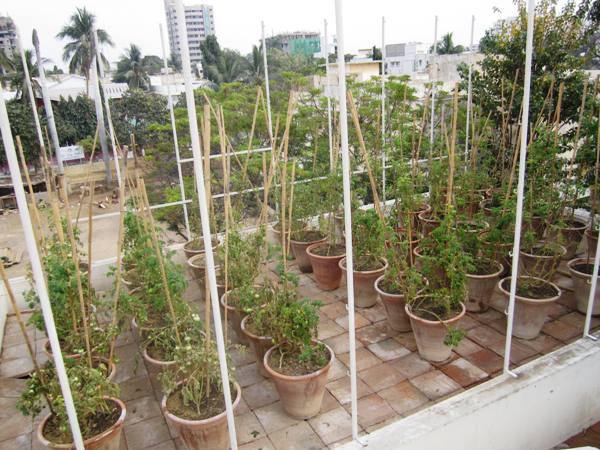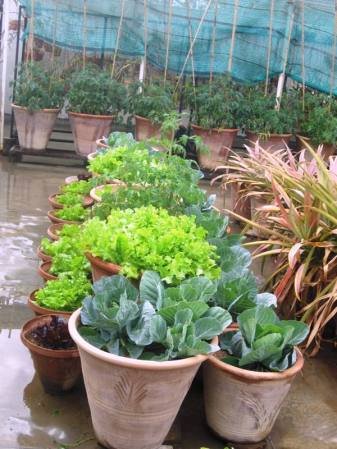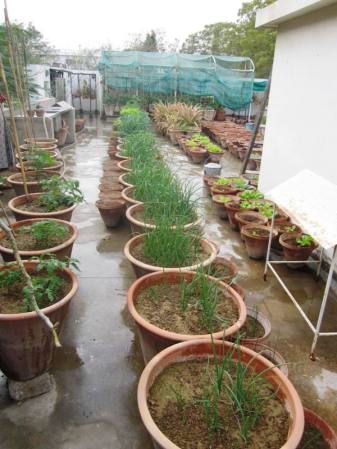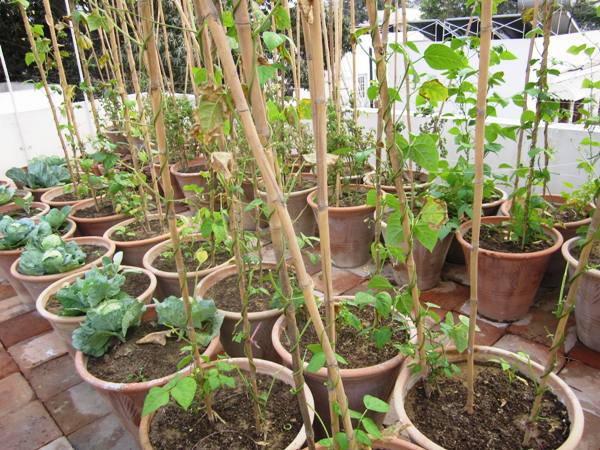
Beat the price hikes with vegetables of your own
To overcome the growing price hike, why not grow your own vegetables and fruits in your backyard?
The connection between humans and plants is as sacred as any religion in the world. They are our ‘fellow beings’ and for better productivity, it is important to understand the divine logic behind a human-plant relationship. When proper care, love and affection is extended towards them, they reciprocate the love by giving us fruits, vegetables and flowers.
The recent soaring prices of vegetables have raised drastic concerns among the masses. Tomatoes have touched a record high of Rs180 per kilogramme (kg), potatoes for Rs60 per kg and onions for Rs100 per kg. The reasons behind this uncalled for price hike are many.
- Money is not being invested properly in the agriculture sector
- With every rise of one degree in the average global temperature, we lose about 10% of the world’s food production
- Massive crop failures in various parts of the world are affecting food prices
- Factors such as Ramazan and occasions like Eid are pet days for a price hike
- Corruption is prevalent in distribution, transportation and hoarding of the products
Increasing food scarcity versus increasing price hikes is a phenomenon prevalent not only in Pakistan but has become a worldwide affair. Even our neighbouring countries have been affected by it.
Pakistan is among those developing countries whose issues regarding food commodities have escalated greatly in the past decade. We have left the tier of ‘alarmingly hungry’ countries and have become part of the ‘seriously hungry’ countries of the world category. According to the latest Global Hunger Index 2013, Pakistan has been characterised as one of those countries that have, to some extent, shown a reduction in their hunger crisis; we have improved our rank from 21.2 in 2005 to 19.3 in 2013. However, this improvement is not enough.
In order to overcome the food shortage and rising prices, now would be a good time to start growing your own fruits and vegetables. Instead of purchasing tomatoes for Rs180 per kg, why not produce 65 kgs of tomatoes in a single season, from a pack of tomato seeds costing only Rs150? This one pack makes 0ne kilogramme of tomatoes every week, which can be stored, preserved and frozen for the coming days. You will not have to buy another pack of seeds for the next season as more tomatoes can be grown from the already planted crops.
 Photo: Amber Alibhai
Photo: Amber AlibhaiSome vegetables that are very easy and convenient to grow in one’s garden include:
Summer Vegetables
Tomatoes, hot peppers, eggplants, cucumbers, okra, gourd family, pumpkins, arums, potatoes, herbs, turmeric, ginger and melons. The best time for sowing their seeds is spring (February and March) and their produce can be reaped till September and October.
Winter Vegetables
Cabbage, cauliflower, broccoli, carrots, potatoes, onions, lettuce, radish, turnip, peas, spinach, fenugreek, beets, mustard seeds, coriander, herbs and garlic. The appropriate sowing time is September and October, and their produce can be reaped till February and March.
 Photo: Amber Alibhai
Photo: Amber AlibhaiThere are a variety of advantages of growing your own organic vegetables and fruits.
You end up saving a great deal of money
People, on average, spend about Rs100 per day for their daily consumption of vegetables, in both cooked and raw form. On the other hand, spending money on vegetable plantation may cost Rs500 per season, on average, including both fertilisers and seeds. Presently, the value of vegetables and herbs produced can average up to Rs3000 per month, which automatically means more savings.
Exceptional savings are possible with early and late sowing. Prepare seedlings of spring plantation for winter underneath plastic sheets and fall plantation seeds in summers underneath shades. These crops will provide you off-season vegetables that are otherwise very costly in the market. However, unforeseen expenses might have an impact on these savings. For instance, at times, a dire need emerges when your plants require sweet water, instead of the salty, tap water. For this, you might have to call in a sweet-water tanker, which would obviously incur expenses.
Saving money every month matters a lot but what matters more in growing your own food is its quality – free from chemicals, protected from sewage or industrial waste water and not artificially treated.
Even your compost can be homemade, which only takes about a week to prepare. The finished product is rich, dark, crumbly and scented. It is made of recycled garden and kitchen waste, including products like egg shells, tea bags, vegetable and fruit peelings, dry leaves, newspaper, poultry manure and the likes. Just cover the waste and the spooning will do its job, but avoid putting meaty leftovers, cooked food, coal, disposable nappies and/or pets’ waste in it.
A fun way to spend time with nature
According to Nighat Ashraf, who owns a roof top garden of her own,
“What better excuse to spend more time outside mucking around in the garden. Do your bit for the environment, save money and share quality food with family and friends, who will value the freshness and sweetness of the produce.”
Get your kids involved as a form of outdoor activity since it is a great learning ground and a preferred and productive pastime than technological toys.
It has health benefits
According to Amber Alibhai, who also owns a garden,
“It’s a great exercise. Consequently, it helps to cut your medical bills, keeps you distracted from depression and offers a great deal of satisfaction, which is enough to stay fit and healthy.”
Your share in the green movement
Finally, growing your own vegetables is a great way to participate in the green movement. The crops you produce use carbon dioxide through the process of photosynthesis. Moreover, having your own vegetable garden means fewer trips to the market. Therefore, you conserve energy and burn less fossil fuel, a great way to reduce your carbon footprints.
In most countries, to avoid food scarcity and harness the desire for non-polluted fresh food, NGOs and other governments are helping people grow vegetables in their kitchen gardens, terraces or balconies. This is quite popular in Bangladesh, Nepal and some states of India.
 Photo: Amber Alibhai
Photo: Amber AlibhaiIn USA and Canada, most organisations and projects are working towards helping communities set up vegetable clusters close to urban areas by allowing farmers to grow vegetables and horticultural produce. They offer techniques and guidance to urban households alongside seeds, drips and other gardening necessities as part of various sponsored schemes for growing vegetables.
However, in order to get the best results, it will require a lot of efforts from your end. In contrast to simple gardening, terrace gardens require more planning. This is where the main investment comes in. The common point that should be kept in mind is that the roof has to be slanted and it should facilitate a proper drainage system. Insulation should be planned accordingly to avoid seepages. It must be sturdy enough to bear the weight of the pots and plants. The positioning of the pots to get the right amount of sunlight is also quite important.
 Photo: Amber Alibhai
Photo: Amber AlibhaiTo start, one would require basic commodities such as pots, nets, composts and seeds; their cost would depend on their size and quality. The cost ranges, on average, between Rs15,000 and Rs20,000. According to Ashraf,
“It’s a one-time investment. I preferred old bath tubs in place of pots, which I grabbed from recycling areas and they didn’t cost me much”.
Amber, however, insists that gardening is a passion that needs to be handled meticulously to get good results. She says,
“I learned the art of gardening from my grandmother. One cannot do this in a casual manner and cannot depend on other gardeners or helpers”.
 Photo: Amber Alibhai
Photo: Amber AlibhaiTherefore, if you’re planning to start a plantation of your own, now is the right time to begin. Some people have a misconception that gardening, while living in an apartment, is impossible; this is not true. One can begin with baby steps, like finding a sunny spot on their balcony or porch and identifying a window sill or even a room in your house or apartment that you can use for plantations and then you are good to go. All you require are a few pots, good amount of homemade compost, seeds, water and some time to reap the fruits of what you sow.




COMMENTS (18)
Comments are moderated and generally will be posted if they are on-topic and not abusive.
For more information, please see our Comments FAQ